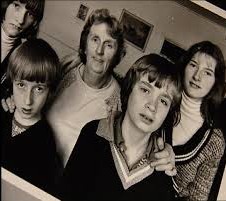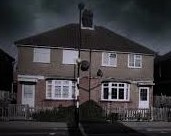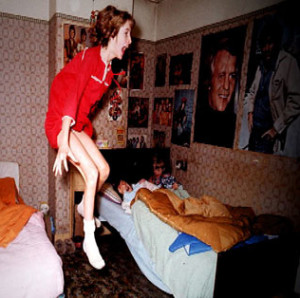“I ain’t got many friends left to talk to. No one’s around when I’m in trouble.”—John Spinks
The Enfield poltergeist case is one of the most famous and unusual hauntings on record. Its fame is the result of its comparatively long duration for a poltergeist disturbance, which allowed it to be witnessed and investigated by many different people, including local police. It’s unusual in that, unlike most cases, the entities involved claimed to be the spirits of formerly living residents from the area whose existence could be verified, thus making this case a kind of haunting-poltergeist hybrid.
 The name by which this case is generally known refers to the Borough of Enfield on the north side of London where the events took place. The house where they occurred belonged to Peggy Hodgson and her children Margaret (13). Janet (11), Johnny (10) and Billy (7). As is almost always the case, most of the disturbances centered around one of the children, in this instance Janet. One of the differences is that things sometimes happened even when Janet wasn’t around, which is quite unusual in poltergeist cases. Nevertheless, there are some who claim that all of this was nothing but a series of pranks perpetrated by her, which I intend to demonstrate is a ridiculous notion. She may have gotten some perverse pleasure out of all of the attention that she received. She might have even embellished her accounts, but this doesn’t even come close to accounting for most of the events as reported by the witnesses.
The name by which this case is generally known refers to the Borough of Enfield on the north side of London where the events took place. The house where they occurred belonged to Peggy Hodgson and her children Margaret (13). Janet (11), Johnny (10) and Billy (7). As is almost always the case, most of the disturbances centered around one of the children, in this instance Janet. One of the differences is that things sometimes happened even when Janet wasn’t around, which is quite unusual in poltergeist cases. Nevertheless, there are some who claim that all of this was nothing but a series of pranks perpetrated by her, which I intend to demonstrate is a ridiculous notion. She may have gotten some perverse pleasure out of all of the attention that she received. She might have even embellished her accounts, but this doesn’t even come close to accounting for most of the events as reported by the witnesses.
The first sign of trouble began on the night of August 30, 1977 when Janet and Johnny, who shared a room, called out for their mother when their beds began shaking. This had stopped by the time she got to the room and she assumed that they were playing childish games with her. The next night, there was a shuffling sound in the room. When Peggy came in to tell the kids to quiet down, the noise stopped, but it started again as soon as she turned off the light. She described it as sounding like someone in slippers trudging across the floor. Then there were four loud knocks,* and when Peggy turned the light back on they saw that a dresser had moved about 18 inches. Peggy pushed it back into place, and it immediately slid back to where it had been. She tried to move it again, but now it wouldn’t budge. Whatever had moved it had obviously decided that they liked it better there.
Not being one to have her furniture arranging acumen called into question, Peggy went next door to ask for help, and her neighbor Vic Nottingham and his son came over to see what was going on. They searched the house for some reason (looking for an invisible interior decorator perhaps?) but didn’t find anything. They had just finished their search when more loud knocking began. Vic ran outside to see if he could catch some prankster in the act, but of course he found no one. This was when they decided to call the police.
Everything was quiet by the time the officers arrived, but the knocking started again when they turned off the lights, and a chair was seen sliding several feet across the floor by everyone present. However, since there’s nothing that the police can do about ghosts, they left shortly afterward. Had this happened in America, they probably would have shot the unarmed chair, but I doubt that would have helped.
All was quiet until the next evening when Legos and marbles started flying around the house at high speeds. One of the children picked up one of these marbles and discovered that it was extremely hot, which is not unusual in poltergeist cases but is more common with objects that seem to materialize out of nowhere than objects that are thrown. Peggy again summoned her neighbor to come see this, and he convinced her to let him call the Daily Mirror for some reason. The paper sent over a reporter and photographer, but by the time that they arrived all of this had stopped. Just after they left, it all started back up again and Peggy ran to the door to call them back. As the photographer steadied his camera to get a picture, a Lego hit him just above the eye and left a nasty bruise. This is one of the few documented cases in which a flying object has done this. Usually they just bounce off of people and the impact is barely felt, even if the object was heavy and moving at a high rate of speed. The only moral it is possible to draw from this story is that one should never let poltergeists play with Legos, but unfortunately there are times when it is unavoidable.
The people at the Mirror were sufficiently impressed by the case to contact the famous Society for Psychical Research (of which Lewis Carroll was a founding member – most people don’t know that). The SPR, however, must not have been too impressed, because they dispatched a fledgling  member named Maurice Grosse to investigate. Grosse had never before investigated any sort of haunting, and he quickly realized that he was in over his head. He managed to recruit veteran psychic investigator Guy Playfair to assist him after just a few days. Playfair had lots of experience with these sorts of things and had cut his paranormal teeth in Brazil, where he had become something of an expert in Umbanda – a Brazilian mixture of Catholicism, European spiritualism and West African magic.
member named Maurice Grosse to investigate. Grosse had never before investigated any sort of haunting, and he quickly realized that he was in over his head. He managed to recruit veteran psychic investigator Guy Playfair to assist him after just a few days. Playfair had lots of experience with these sorts of things and had cut his paranormal teeth in Brazil, where he had become something of an expert in Umbanda – a Brazilian mixture of Catholicism, European spiritualism and West African magic.
Playfair immediately identified Janet as the being the focal point for the unusual occurrences. One night while he and a photographer from the Mirror were alone in Janet’s room, a marble fell to the floor with a loud thud. Rather than rolling away as a marble should after being dropped, this one stayed right where it had landed. Playfair tried to duplicate this without success. The photographer tried to take a picture of the mysterious marble, but all three of his flashes refused to work. All of them had been drained of power even though he had fully charged them before he arrived. This is also common, but more so in cases involving UFOs, cryptids and crop formations. I wouldn’t take any piece of electronic equipment that I didn’t want irreparably damaged into one of those.
For reasons that are not clear, at least to me, Playfair then decided to try an experiment. He tied one of the legs of a chair next to Janet’s bed to one of the legs on the bed with wire. Within a few minutes, the chair fell over, cleanly snapping the wire in the process. He decided to try it again, this time twisting the wire around itself like the knot at the base of a coat hanger’s hook so that it was several times stronger. The chair fell over again, with the wire once again snapped like a twig. An armchair then tipped over, and a book flew off the shelf, landed on the floor, and then “rolled” several times like a square wheel before eventually landing upright. The name of the book was Fun and Games for Children.
Just after this, an indentation appeared in the pillow on Janet’s bed, as if someone had laid (lain?) down for a rest. The head, if there was one, was small, giving the indication that it was that of a child. This was when Ms. Hodgson admitted that she thought that the ghost was that of a four-year-old girl that her father had suffocated in a nearby house (!?!). As it turned out, this didn’t appear to have been the case†. And somehow, they all seem to have been able to resist the urge to go jump on the bed to see what would have happened. Perhaps none of them were so whimsical as I, but as usual, I digress.
As I said, I’m not sure why Playfair decided to try this experiment with the wire, but there was obviously a method to his madness because it yielded some very impressive results. Perhaps he was daring the entity to show him just what it was capable of doing. If so, it not only took the bait, but also demonstrated very clearly that its abilities far exceeded those of any tween-age prankster. Janet may have been a handful, but unless she was hiding under the bed with a pair of wire cutters, there’s no way that she could have pulled this stunt off. And that doesn’t even take into account the trick with the tumbling book and the impression on the pillow. Perhaps she also had an invisibility ring that was slowly driving her balmy?
 Theoretical invisibility rings aside, Playfair decided that the near constant knocking at this point indicated that the entity wished to communicate with them. To this end, he brought in a psychic named Annie Shaw and her husband George, who functioned as a kind of control. Upon entering into a trance, Annie suddenly shouted “Go away!” and then began cackling like an old woman. When George tried to speak to her, she spat at him and then moaned “Gozer, Gozer help me? Elvie, come here.” George then demanded that the entity depart and leave the Hodgson family alone. When she came out of her trance, Annie said that she believed that a number of spirits were responsible for the haunting, including the old woman who had spoken through her. George believed that this “Gozer” that she had mentioned (probably no relation to Gozer the Gozerian) was a nasty fellow who had been involved with black magic, and Elvie was an elemental, probably of the thoughtform variety. Both of the Shaws thought that these beings were “feeding” on energy that was leaking from Peggy and Janet. They performed a psychic healing on the two, and almost all paranormal activity in the house ceased for several weeks afterward.
Theoretical invisibility rings aside, Playfair decided that the near constant knocking at this point indicated that the entity wished to communicate with them. To this end, he brought in a psychic named Annie Shaw and her husband George, who functioned as a kind of control. Upon entering into a trance, Annie suddenly shouted “Go away!” and then began cackling like an old woman. When George tried to speak to her, she spat at him and then moaned “Gozer, Gozer help me? Elvie, come here.” George then demanded that the entity depart and leave the Hodgson family alone. When she came out of her trance, Annie said that she believed that a number of spirits were responsible for the haunting, including the old woman who had spoken through her. George believed that this “Gozer” that she had mentioned (probably no relation to Gozer the Gozerian) was a nasty fellow who had been involved with black magic, and Elvie was an elemental, probably of the thoughtform variety. Both of the Shaws thought that these beings were “feeding” on energy that was leaking from Peggy and Janet. They performed a psychic healing on the two, and almost all paranormal activity in the house ceased for several weeks afterward.
It didn’t last. In late October, it came back with a vengeance. Objects flew, beds shook, and covers were ripped off of the sleeping family during the night. Grosse and Playfair recorded nearly 400 manifestations in a matter of weeks. Pools of water with sharply defined edges also began appearing, as in the Black Monk poltergeist case. One of these puddles was shaped like the outline of a person. There were also some potentially dangerous demonstrations of force. An iron grill flew across the room and landed on Billy’s pillow while he was in the bed. If it had landed a few inches further to one side, it could have killed him. The next evening, a gas fireplace was ripped out of a brick wall.
For some reason, I feel compelled to mention again that there are those who still maintain that all of this was a hoax perpetrated by Janet, at times with the help of her older sister. The commonsense question one must ask at this point is if you think that a pair of adolescent girls could yank a cast iron fireplace out of a brick wall. If your answer is yes, I don’t want to meet the kids in your neighborhood.
Since trying to communicate with the entities behind the disturbances via a psychic had yielded only limited results, Playfair decided to go old school and try to converse with them using the classic, Fox sisters system of raps, viz.: once for yes, twice for no. Unfortunately for him, he jumped the gun a bit. One of the first questions that he asked was if the spirit didn’t realize that it was dead. This didn’t go over well. It was answered with an immediate series of crashes that came from one of the rooms upstairs. When they went up to investigate, they found that one of the bedrooms had been virtually ransacked. Furniture had been overturned and items were scattered everywhere. After this, the entity would no longer communicate with him, and subsequent rap sessions had to be handled by Maurice Grosse while Playfair listened in from another room. This was somewhat of a rookie mistake being made by a seasoned investigator who should have known that ghosts usually don’t take kindly to being told that they’re dead, no matter how obvious that might seem to be from our perspective.

Over the next few weeks, the case proceeded into the next phase, albeit one that most poltergeist cases never make it to. The children began to see shadowy figures around the house, and Billy was terrified one night when he noticed the disembodied face of an old man staring at him. Janet was repeatedly thrown from her bed during the night, and one of these instances was captured by a photographer. She then went into convulsions, and Grosse and the photographer had to hold her down to prevent her from injuring herself. The next night, she suffered more convulsions, then began wandering around as if in a trance, muttering “Where’s Gober? He’ll kill you.”
Soon after this, the spirits began doing something that only occurs in a small minority of poltergeist cases. They started speaking on their own. And with that compelling tidbit now in place, this seems like a perfect stopping point. We’ll pick it up from here next week.
But before I call it a night, one final note: Since Janet and Margaret have since admitted to playing a few pranks and blaming them on the ghosts, some take this as a virtual confession that the whole thing was a hoax. In fact, nothing could be further from the truth. If you would like to know more about this, you can read an article from 2007 where they discuss all of this here. There are plenty of quotes from them concerning this aspect of the case in this article, as well as others stating their insistence that their pranks constituted no more than a small percentage of the phenomena reported by Playfair, Grosse and other investigators. Since the skeptics completely misrepresent all of this (presumably out of habit), I think it only fair to ask the open-minded to read their words for themselves. The closed-minded can do whatever the hell they want.
___________________________________________________________________________________
*Usually these come in threes.
†This piece of information came from Colin Wilson’s book Poltergeist, and he didn’t elaborate on the details surrounding this rather disturbing revelation. No other source that I’ve been able to locate mentions it at all.


